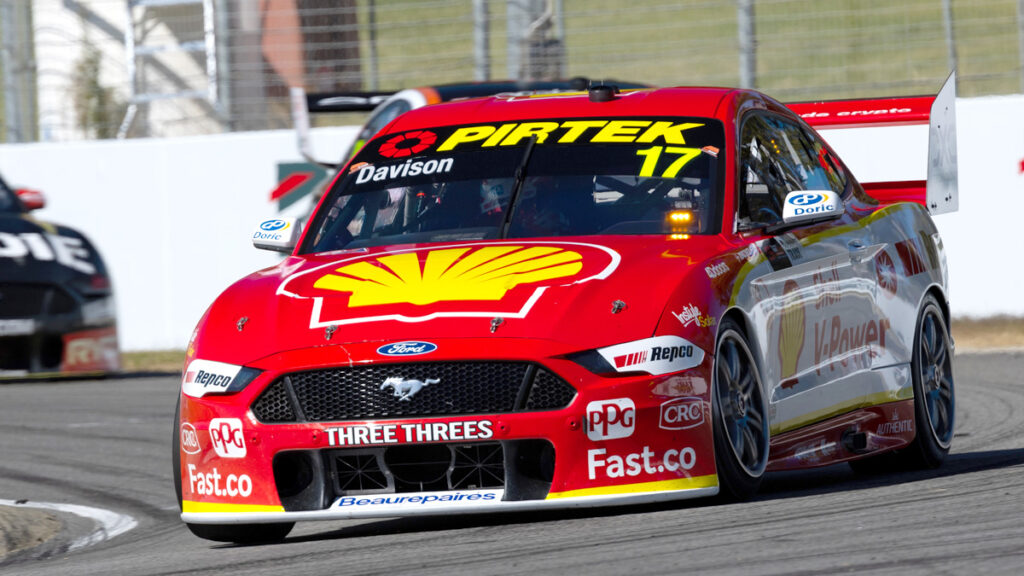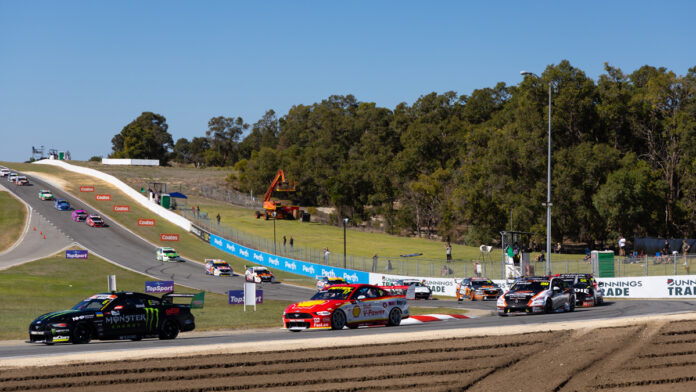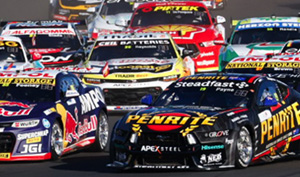SUPERCARS Driving Standards Advisor Craig Baird has clarified the reasoning and rulings relating to a pair of incidents in last weekend’s Repco Supercars Championship round at Wanneroo in Western Australia.
Cam Waters and Tickford Racing were left aggrieved that a five-second post-race time penalty for gaining a lasting advantage upon re-entering the circuit in Race 11 moved the Monster Mustang driver from first-across-the-line to fourth place in the final results.
Waters had been battling for the lead with Shell V-Power driver Will Davison in Race 11 when the latter made a diving pass into the last corner, Turn 7, on lap 27.
Davison was aggrieved that his 2020 Bathurst 1000 runner-up partner had gone outside of the track limits to take back the position and carry on in the lead of the race.
Despite the Waters penalty being presented on the TV broadcast as being for ‘dangerous re-entry’ to the circuit, it was in fact for gaining a lasting advantage upon re-entering the circuit.
Baird, in particular, has been the subject of horrendous social media abuse since the weekend’s round, so much so that Chaz Mostert and Davison have led the charge online in recent days for greater accountability from ‘fans’ launching personal, direct and disturbing attacks towards Baird rather than simply voicing an opinion.
The former V8 Supercar racer explained that the Waters/Davison scenario is based around safety.
“We’re (Race Control officials) fully accountable for all matters that relate to track safety,” Baird told V8 Sleuth this week.
“The boundary lines are there for a reason. A lot of work has gone into things from Motorsport Australia and Supercars in order to homologate and run a safe circuit.
“If someone in a support race or another category sees what happened with Cam, and if it goes unpenalized, it’s effectively an open invite for them to go and do the same thing.
“In that case, if someone else decides to just go flat strap around the back of the kerb, is unlucky enough to hit some sand or oil or debris and ends up headfirst into the pit wall in front of the old pit lane, there’s a serious injury waiting to happen if we let competitors go outside the framework of the track limits.
“The facts are that Cam was 11 metres outside the track limits – that’s not OK. He took advantage of that and gained a lasting advantage on re-passing Will.
“I looked at all of the TV vision available and Cam had a choice to either breach a rule by going around the outside of the kerb, or not. It was Will’s position; he had the move done and Cam made the decision to turn into him and then charge to the back of the kerb.
“After all, who passes anyone around the outside at a corner like Turn 7 in Supercars, the category where all of the drivers are of the highest level?
“You can’t and don’t just drive around the outside of a guy who is up the inside. It was Will’s position and Cam didn’t concede it, he had a decision, and he chose to go outside the boundary of the track limits.”

A range of fans have highlighted other instances from the weekend’s round where drivers that went to the left of the Turn 7 exit kerb went unpunished.
Baird points out that in those other cited examples online that the driver/s in question were in front of the following car entering the corner, in front at the apex of the corner and in front at the exit of the corner, therefore not gaining a lasting advantage in comparison to Waters passing Davison while outside track limits.
“Obviously, when the win or a podium position is on the line, the spotlight is more focused there than in the mid pack,” he added.
“For sure, stuff happens in the ‘war zone’ in the mid-pack all the time and occasionally some of those might get missed.
“Motorsport is unlike any other sport. It’s like a football game with 25 footballs in the air across 2.4 kilometres of field, it’s impossible to be across absolutely every single instance, even with the cameras and tools we have available.
“We do the absolute best with what we’ve got. Do we sometimes miss things? Sure, sometimes it happens. Do we sometimes get it wrong? Sure, we’re human. We simply applied the rule book to that situation last weekend, and it was the right call.
“The other thing people watching on TV need to remember too is that all of the drivers have an allocation for kerb strikes and going outside track limits.
“We don’t have someone strike a kerb or go outside track limits and they immediately get a penalty just for going out there on one instance. There’s an allocation per driver that the Stewards, Race Director and I determine in a meeting prior to each race. It’s not ‘one strike and you’re out’.
“We have a leeway for the drivers because we know you can’t stop someone from accidentally going behind the kerb or overcommitting to a corner and locking a brake and running wide, so the five second penalties in those situations come from when their allocation is used up.”
In the case of the contact between Scott Pye and Jack Le Brocq that ended up with the former’s Team 18 Commodore crashing into the pit wall in the early stages of Race 11, no penalty was applied to either driver.
“In that incident, neither party was fully to blame,” said Baird.
“By the rule book I am given to work from, no one driver was wholly or predominantly to blame.
“Scott moved across and across and across to the right of the track, Jack didn’t have to lift. Both could have done things differently, but there was no action taken given neither of them was wholly nor predominantly to blame.”




